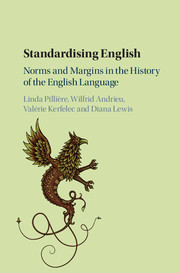Book contents
- Standardising English
- Standardising English
- Copyright page
- Contents
- List of Figures, Maps and Tables
- List of Contributors
- Acknowledgements
- Part I Norms and Margins: Ideology and Concepts
- Part II Norms and Margins: A Historical Perspective
- Part III Norms and Margins: Moving into the Twenty-First Century
- 10 The Grammatical Margins of Class
- 11 Concepts of Correctness and Acceptability in British English: Exploring Attitudes of Lay People
- 12 Maori English in Maori Literature: Standardising the Margin into a Norm
- 13 Imposing a Norm: The Invisible Marks of Copy-Editors
- Author Index
- Subject Index
- References
10 - The Grammatical Margins of Class
from Part III - Norms and Margins: Moving into the Twenty-First Century
Published online by Cambridge University Press: 02 March 2018
- Standardising English
- Standardising English
- Copyright page
- Contents
- List of Figures, Maps and Tables
- List of Contributors
- Acknowledgements
- Part I Norms and Margins: Ideology and Concepts
- Part II Norms and Margins: A Historical Perspective
- Part III Norms and Margins: Moving into the Twenty-First Century
- 10 The Grammatical Margins of Class
- 11 Concepts of Correctness and Acceptability in British English: Exploring Attitudes of Lay People
- 12 Maori English in Maori Literature: Standardising the Margin into a Norm
- 13 Imposing a Norm: The Invisible Marks of Copy-Editors
- Author Index
- Subject Index
- References
Summary
- Type
- Chapter
- Information
- Standardising EnglishNorms and Margins in the History of the English Language, pp. 193 - 212Publisher: Cambridge University PressPrint publication year: 2018



